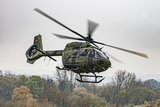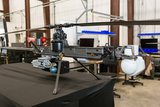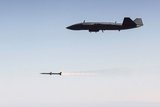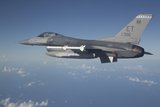HAWC missile completes flight trials as focus turns to maturing hypersonic technology
A rendering of a HAWC hypersonic missile concept. (Image: DARPA)
The joint DARPA/USAF Hypersonic Airbreathing Weapon Concept (HAWC) has completed its final planned flight test. The Lockheed Martin version of the HAWC scramjet-powered missile has provided critical data to inform Air Force Research Laboratory (AFRL) hypersonic technology maturation work.
The most recent flight demonstrated 'improved capabilities and performance' according to DARPA. This means the US now has two feasible hypersonic airbreathing missile designs (from Lockheed Martin and Raytheon) to use as the basis for future weapon systems.
Andrew Knoedler, HAWC programme manager, said: 'HAWC [has] brought a wealth of data and progress to the airbreathing hypersonic community. The industry teams attacked the challenge of scramjet-powered vehicles in earnest, and we had the grit and luck to make it work.'
Related Articles
Software-defined technology is 'democratising' electronic warfare, says DARPA official
The future is hypersonic strike for Zumwalt destroyers
Airbus joins UK efforts to defend against hypersonic threats
Although the HAWC programme has executed its final phase, data analysis continues and DARPA plans to advance maturation in the More Opportunities with HAWC (MOHAWC) effort by building and flying more vehicles that build upon HAWC’s advances. These missiles will expand the operating envelope of the scramjet and provide technology on-ramps for future programmes of record.
More from Air Warfare
-
![Germany acquires additional 20 H145M helicopters]()
Germany acquires additional 20 H145M helicopters
The order for the extra helicopters comes from an agreement penned in December 2023, with the German Army receiving the bulk of the platforms.
-
![Anduril UK and GKN Aerospace collaborate on British Army ACP bid]()
Anduril UK and GKN Aerospace collaborate on British Army ACP bid
The pair will submit their demonstrator concept for Project Nyx, a development project for the British Army’s Land Autonomous Collaborative Platform.
-
![US Army command’s Picatinny CLIK common lethal drone interface makes progress]()
US Army command’s Picatinny CLIK common lethal drone interface makes progress
The Picatinny Common Lethality Integration Kit is designed to overcome the issue of unique integration methods between lethal payloads and drones as well as avoiding problematic acquisition conditions created by vendor lock.
-
![Australia invests extra A$1.4 billion in MQ-28A Ghost Bat after successful missile fire test]()
Australia invests extra A$1.4 billion in MQ-28A Ghost Bat after successful missile fire test
The investment includes new contracts for six MQ-28A Ghost Bat aircraft, as well as provisional funds to invest in the development of a Block 3 prototype.
-
![US approves potential $4.7 billion missile and air defence system sales to Denmark and Italy]()
US approves potential $4.7 billion missile and air defence system sales to Denmark and Italy
Italy could field the JASSM-ER for its combat aircraft including the F-35, while Denmark has been approved for AMRAAM and an Integrated Battle Command system procurement.
-
![Northrop Grumman to fly new Project Talon CCA by late 2026]()
Northrop Grumman to fly new Project Talon CCA by late 2026
The newly unveiled collaborative combat aircraft looks to strike a balance between capability and cost-effectiveness, according to the company.

























